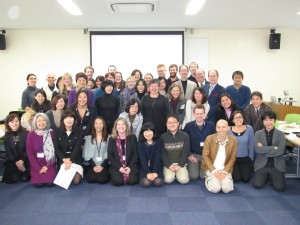Uses & Gratifications of Boys‘ Love Manga – Fujoshi in Japan and Germany
Presentation at the workshop “Glocal Polemics of ‘Boys Love’ [BL]: Production, Circulation, Censorship” at Oita University, 2011/01/22-23.
A presentation of my research on the use of boys’ love (BL) manga. Based on an interactionist perspective that builds on theories of media gratification, entertainment and emotions, my research focuses on the “how” of the usage and understands media preferences (including BL) as arising from historical, biographical and situational contexts.
Abstract
Analogous to sociological research on ‘deviant’ behavior and media preferences in general, layman questions like “Why do they do it?” and their essentializing or pathologizing answers still make up a prominent part of the discourse on Boys’ Love (BL) and fujoshi. The ‘common sense’ logic behind these questions tends to ignore individual modes of consumption, experiences and ascriptions of meaning.
Following the gradually more differentiated view on the tayōsei (diversity) of BL content and answering the critique on the discourse’s narrowness, I propose a theoretical framework for the research on BL use and appropriation that simultaneously offers openness and integration.
Based on an interactionist perspective that builds on theories of media gratification, entertainment and emotions, as well as escapism (as a mode of reception) and happiness, my research is less concerned with the “why”. Focusing on the “how” instead, I understand media preferences (including BL) as arising from historical, biographical and situational contexts.
Qualitative interviews I conducted in Japan and Germany as part of my M.A. thesis showed that BL or BL use cannot be understood if one limits the analysis to content. The gratifications users gained and sought/expected are quite diverse, ranging from the physiological (arousal) and the social (exchange, belonging), the cognitive (parasocial interaction) and the aesthetic (immersion) to self-actualization, to name a few. Based on my sample, compromised of mostly students, I constructed four categories of fujoshi/fudanshi that are not comprehensive, but highlight the BL users’ diversity: the connoisseuse, the con-girl, the net-girl, and the sporadic.
Keywords
boys’ love, fujoshi, manga, qualitative research, symbolic interactionsim, uses & gratifications
Further reading
EUREKA (2007). Fujoshi Manga Taikei. (Fujoshi Manga Overview). Special Issue 39/7. Tōkyō: Seidosha.
— (2007). Sōtokushū – BL (boys‘ love) Studies. (Complete-Feature: BL (boys‘ love) Studies). Special Issue 39/16. Tōkyō: Seidosha.
Kamm, Björn-Ole (2010). Nutzen und Gratifikation bei Boys’ Love Manga – Fujoshi oder verdorbene Mädchen in Japan und Deutschland (Uses and Gratifications of Boys‘ Love Manga – Fujoshi or rotten girls in Japan and Germany). Hamburg: Kovac.
Nakajima, Azusa (1995). Komyunikēshon-fuzen-shōkōgun. (Communication insufficiency syndrome). Tōkyō: Chikuma. [Original 1991].
Renckstorf, Karsten & Fred Wester (2004). “The ‘media use as social action’ approach: Theory, methodology, and research evidence so far“. In: Karsten Renckstorf, et al. Action Theory and Communication Research. Recent Developments in Europe. Berlin, New York: Mouton de Gruyter: 51-83.
Yoshinaga, Fumi (2007). Ano hito to koko dake no oshaberi. (Just chatting with some people here).Tōkyō: Ōta.

